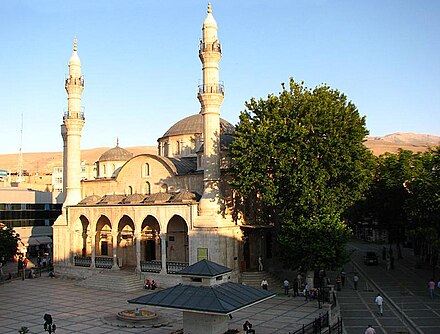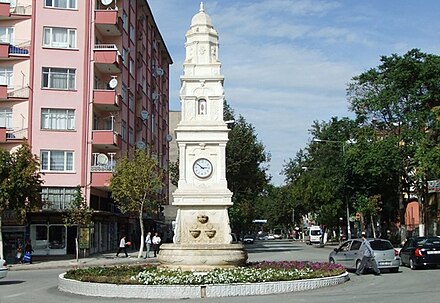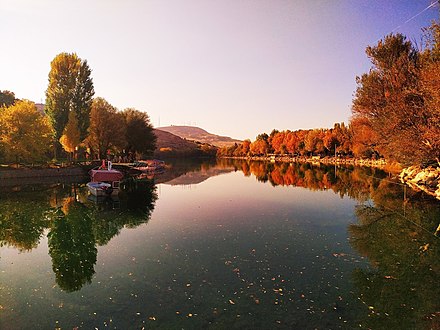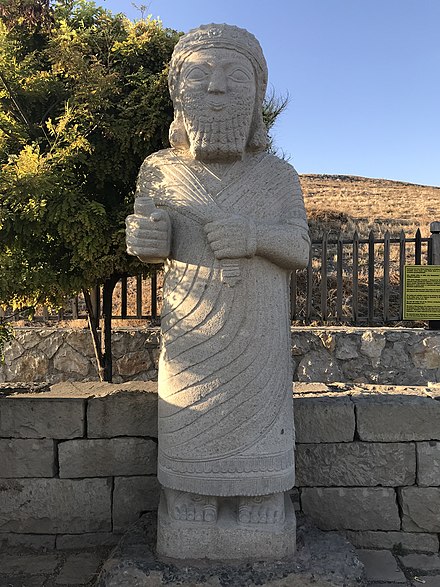Malatya - metropolitan municipality in Eastern Anatolia, Turkey
Warning: On February 6th 2023 Malatya, was hit by a devastating earthquake. Many of the city's buildings and landmarks are badly damaged or collapsed.

Malatya is one of the biggest cities in the Eastern Anatolia region of Turkey.
Understand
Malatya is a relatively new city by Turkish standards, although its ancient name, Malidiya, dates back to the Hittites, a Bronze Age people of Anatolia.
In 1838, during a war between the Ottoman Empire and the forces of Ibrahim Pasha of Egypt, the Ottoman army seized what was then the town of Malatya, forcing the local population to Aspuzu, then a collection of cottages amidst the orchards in the outskirts of the town. After the war, the people decided not to return to their battered town, settling permanently in Aspuzu and renaming it to Malatya (the abandoned old town, 10 km north of the present-day city, was later re-populated, and is now called Battalgazi, covered in its separate article).
Today, with a population of over 600,000 (2021), Malatya is the largest city of central-eastern Anatolia, where the gently rolling steppes of Central Anatolia give way to the heavily-rugged terrain of Eastern Anatolia. The plateau on which Malatya sits is surrounded by higher mountains, some of which are covered with orchards that produce the apricots the city is famous for.
Unlike the rest of Eastern Anatolia, much of the urban population speak a non-dialectical standard Turkish, sometimes with a slight accent.
Local people are generally friendly and helpful.
Climate
A semi-arid continental climate reigns in the area, with hot (and sometimes sweltering), dry summers and cold, snowy winters. The rainiest time is spring, when a storm season brings showers and thunderstorms, while fall (especially October) is mild and generally pleasant.
Get in
By plane
- Malatya Erhaç Airport (IATA: MLX), 38.435278°, 38.090833°. Flights leave from Istanbul and Ankara. Turkish Airlines, AnadoluJet, Pegasus Airlines and Onur Air have daily flights to Malatya. If bought one month prior to the flight date, a one-way flight between Istanbul and Malatya costs between 114 and 154 TL, depending on the company.
By train
Direct trains run daily from Ankara to Malatya, taking 16 hours. There are couchettes and a sleeping car but no buffet. The main stops along the route are Kayseri and Sivas. Twice a week the train continues east via Elazig to Tatvan (the Vangölü Express, 10 hours), with dolmus connections to Van. Trains the other days (the Guney Kurtalan Express) continue to Diyarbakir (6 hours) and Kurtalan (9 hours). For details see Turkish railways website at tcddtasimacilik.gov.tr. The timetable and the online booking system give different days of running for these services. A high-speed line is under construction from Ankara eastwards. This will greatly reduce journey times when the first section to Sivas opens, but don't hold your breath — the grand opening has been postponed every year to the next since 2018.
The Firat Express runs daily from Malatya, south to Adana, taking 8 hours via Gölbaşı and Osmaniye, and north to Elazig (3 hours).
Malatya's railway station is some 5 km northwest of the city centre, about 200 m off the intercity highway - look for the small white sign saying TCDD Gar at the roundabout with a Carrefour store at one side. Dolmuses and town bus lines #1A and #1B run frequently to the central square.
By car
Malatya can easily be reached by car, via Kayseri-Malatya motorway, which is numbered D300.
By bus
There are many domestic coach firms from Istanbul bus station. The coaches, reach Malatya via Ankara and the journey takes nearly 15 hours. Beydağı Turizm, Aksoğanoğlu Zafer Turizm, Kernek Turizm have at least 5 daily coaches to Malatya within the specific times of the day.
Buses from Ankara, which also shortly call at Kayseri bus station on the way, take between 9 and 11 hours depending on the service, costing 35 TL on the average. In addition to some of the local companies based in Malatya listed above, nation-wide Metro Turizm operates on this line, too.
Long-haul buses from other major centres in the country, both regional and elsewhere alike, such as Bursa, and Van also call at and accept passengers for Malatya bus station.
Malatya's bus station (otogar) lies at the western outskirts of the city, on the highway from Kayseri and way out of city centre. Luckily, quite frequent public buses, which call at the stops on the highway in front of the station (cross the street for eastbound buses, i.e., those heading for the city), connect it with the city centre (although not all of the buses calling at that stop make it to the city centre—some proceed to the suburbs on the other side of the city via the intercity highway). The earliest public bus services start around 06:00.
The name of the bus stop in front of the otogar (as well as the administration of the station itself) is Maşti, so look for that in bus signs when getting from elsewhere in the city.
The bus station has an official tourism information office, an internet cafe open 24-hr, toilettes (which cost 0.75 TL), as well as benches which might offer a quite uncomfortable sleep if you arrive in the middle of the night. The place is calm and safe through the night with a visible presence of security officers.
Get around

The city has a wide number of public buses, some fairly modern and some quite old, easily recognizable by their flashy yellow colour and big Malatya Belediyesi ("Malatya City Council") banners on the sides. However, not every of them heads into downtown, some ply up and down the intercity highway (which is named Çevreyolu on the maps and such, literally "ring road", however it's a wide avenue through the residential neighbourhoods of the city rather than a motorway surrounding the city nowadays), which lie a few blocks north of the main street of city centre. The bus stops at the central square are called Valilik or Vilayet (both mean "Governor's Office", and it seems there is no fixed standard for it—it's possible to see both words on bus signs), so make sure you catch one heading for there when you want to make it right to the downtown. A ride, regardless of the distance or the direction, costs 1.25 TL.
Once in the center, everywhere is easily accessible by foot as the city lies on a fairly flat ground, except for southern neighbourhoods leaning against a steep hillside, which an average traveller takes little, if any, interest anyway.
See
- New Mosque (Yeni Cami), 38.349871°, 38.317963°. A beautiful mosque built in 1912, and one of the few in Turkey featuring three minarets. The one on the side—top of which was demolished long ago—was perhaps the minaret of an older mosque on site.
Post-2023 earthquake status: leveled. Free
- Just across the street from the New Mosque at the front yard of Governor's Office is the last standing statue of İsmet İnönü, a native of the city and the second president of Turkey (in office 1938-1950), who was later blamed for instituting a cult of personality for himself after the death of Turkish Republic's founder, Kemal Atatürk.
From the central square, a stroll of 800 metres along the Fuzuli Caddesi (Street) will bring you to Kernek Square (Kernek Meydanı).
- Waterfalls Park (Şelale Parkı), Kernek Meydanı. A park on the side of a hill with lots of water features. A man-made waterfall running through a concrete canal and getting stronger at each upper cascade is the main attraction. The park surrounds a small hydroelectric power plant harnessing the power of the waterfall—the reason why the waterfall exists in the first place—although the plant is not open for visits. Some open-air cafes line the cascading water canal. Free
- Museum (Müze), Kernek Meydanı (next to the park), 38.343333°, 38.323889°, +90 422 321-30-06. Tu-Su 08:00-12:00 and 13:00-16:45. 3 TL
The waters of the waterfalls park keep running along a canal spanned by pleasant foot bridges in the leafy median strip of Hamit Feritoğlu Caddesi, unofficially known as Kanalboyu (literally "along the canal"). A stroll of about 500 metres along the Kanalboyu will bring you to another square.
- On the side of the square is Hürriyet Park, the largest in the city.
- At the side of the entrance of the park is a statue of Kemal Atatürk, complete with his cloak, next to a guy, presumably symbolizing Turkish youth, who is wearing nothing but a fig leaf.
Heading back to northwest from here along Kışla Caddesi—which has a beautifully landscaped wide median strip, which includes benches and palm trees (yes, palm trees. Like those that are found in tropical paradises. All thanks to legendary cold hardiness of Trachycarpus fortunei species)—you will arrive back at the central square; drawing a triangle in the city. However, there are a few more sights on the way, which might slow down your pace a bit.
- Atatürk Museum (Atatürk Evi Müzesi), Kışla Caddesi (very close to Hürriyet Park), 38.348346°, 38.325583°. Tu-Su 09:00-12:00 and 13:00-17:00. The historic mansion in which Kemal Atatürk stayed during his visits to the city.
- There are also a number of other historic stone buildings along the Kışla Caddesi from the late Ottoman or early Republic eras, which look quite stately and impressive.
- At yet another square on your way, there is an old-looking clock tower, which was built in modern times but is nice anyway.
Outer neighbourhoods

- There is a large park east of the city, on the highway to Elazığ with a large pond and distant views of the Karakaya Dam lake. Minibuses and public buses heading for Üniversite pass by the entrance of it.
- Northwest of the city centre (on Boztepe Caddesi a block north of the intercity highway-çevreyolu) is Taşhoron Church, an Armenian church restored in 2021 to a brand-new look, complete with an iron-cast dome weighing 19 tonnes, after staying derelict for decades. The neighbourhood in which it stands seems to be a somewhat rough one, so a distant look from the highway might suffice unless you have a special interest in the Armenian heritage of the region.
Post-2023 earthquake status: moderate damage, closed to visits.
Do
- Visit during the Malatya International Arts and Apricot Festival in July.
- Go to Malatya Park AVM (shopping mall), the largest mall in eastern Turkey. An ice skating rink and a movie theater with subtitled films are also available there.
Buy
Eat
The city is known for huge apricot orchards of the surrounding countryside, and it's possible to sample a number of local products based on apricot, from the usual dried apricots to highly unique shish kebabs with grilled apricots.
Budget
Mid-range
Splurge
Drink
There are a number of cafes along the Kanalboyu, some of which serve hookah (nargile).
- Nostalji Cafe. Housed in a two-floor historic building, this is the place to try traditional drinks such as Turkish coffee, sahlep, or kefir.
- Genç Girişimciler Derneği, Kışla Caddesi. The only pub in Malatya.
Sleep
Budget
Mid-range
- Murat Palancı Oteli Turgut Temelli Cad. No: 26 Malatya; +90-422-3251003
- Yeni Butik Oteli Yeni Camii Karşısı Zafer iş Hanı No:1 Malatya; +90-3231424
- Otel Avşar. Çevreyolu, Eski Otogar Karşısı Malatya; +90-422-3248491
- Bezginler Hotel Çevreyolu Adliye Kavşağı No:12/3 Malatya; +90-422-3241252
Splurge
- Ramada Plaza Malatya Altin Kayisi, Ozalper Mahallesi Ankara Caddesi, +90 0422-2114444. Check-in: 14:00, check-out: 12:00. 2017-06-13
Connect
The area code of Malatya is (+90) 422.
There is an internet cafe on the corner of Kernek Square and Fuzuli Caddesi, opposite the Waterfalls Park.
Stay safe
Connect
As of Dec 2020 Malatya has 4G from all Turkish carriers - coverage of the surrounding highways is variable. 5G has not yet reached this area.
Go next

- Battalgazi — the original location of Malatya, Battalgazi has some remnants from its past, including the beautiful Seljuk-built Great Mosque
- Orduzu — this nearby village to the northeast is the site of the world heritage listed Arslantepe Ruins (Tu-Su 08:00-17:00, free), once the eastern outpost of the Hittites.
Post-2023 earthquake status: closed to visits.
- Elazığ — a regional city to the northeast, surrounded by mountains and lakes, it is the hub for visiting the old town of Harput
- Kemaliye — an old town in the rugged Upper Euphrates Valley to the north; the nearby Dark Canyon is an adventure sports destination
- Mount Nemrut — Malatya can serve as a convenient jump off point to the well-known sacred mountain, topped by statues devoted to ancient Gods. During spring and summer, you can join the daily trips starting from the tourism information centre in the city hall (Vilayet).
- Darende — a historic town to the west with traces of past civilizations as well as an attractive canyon complete with waterfalls
- Kayseri — several hours to the west, Kayseri is a good hub for visits to Cappadocia, or onward trips to Ankara, the national capital
Malatya
malatya.bel.trMalatya
Primary administrative division